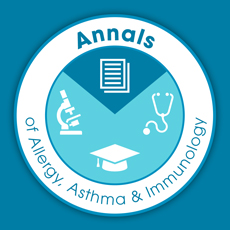 As spring begins its march toward summer, the tree pollens will give way to the beginning of grass season. This transition will keep the patients coming who need our help to manage their allergy, asthma and/or immune-based diseases. We have features in the April issue of the Annals of Allergy, Asthma and Immunology that should help you in your patient management strategies.
As spring begins its march toward summer, the tree pollens will give way to the beginning of grass season. This transition will keep the patients coming who need our help to manage their allergy, asthma and/or immune-based diseases. We have features in the April issue of the Annals of Allergy, Asthma and Immunology that should help you in your patient management strategies.
With the continued emphasis on socioeconomics of allergy, I encourage you to read the review from Ruchi Gupta, MD, MPH, and her group at Northwestern University in Chicago on the economics of food allergy. In this paper, the emphasis is not as much on expensive therapies (although they are on their way), but rather the economic impact of food allergy. Economic impact may relate to morbidities, necessary lifestyle changes to avoid offending foods, and the psychological/social impact for these patients and/or their families. The significant burden will have to be weighed as new targeted therapies come online to mitigate some of the risk associated with this illness.
One cannot consider socioeconomics and allergy without thinking about the socioeconomics of biological therapies for asthma. Knowing which drug to give, when to give it, whether it is really needed and for how long already plagues those of us who prescribe these for our patients. Matthew Rank, MD, FACCAI, and John Oppenheimer, MD, FACAAI, provide a very thought-provoking perspective about when to use (and not use) biologics as a category for asthma therapy and what steps should have been taken prior to initiating biological therapies. They emphasize the need to be certain we are making best use of these agents. Avoiding the twin traps of overuse and underuse will retain the necessary resources to continue to provide these products for those who need them most.
William Anderson, MD, and Stanley Szefler, MD, FACCAI, review the specifics of cost effectiveness of biologics in asthma management. They begin by reviewing data that suggest a reduction of 60% cost for biologics would be necessary before being able to accurately assess cost effectiveness. The major measure, reduction in exacerbations, may have population economic benefits but raises the concern at the individual level. The impact on quality of life appears to be modest at best. This article should help to further refine our thinking about selection and utilization practices for the asthma biologics. As more products come to market, these principles described in the article will only grow more important.
I hope you will have some quality down time during this busy season. Take some time with a cool beverage and comfortable surroundings to peruse the April Annals issue. Let me know if you have any comments about our offerings, particularly those you might like to share with your colleagues and other readers. Send them to the Annals editorial office or to me directly. We will see that they are shared with others in a future issue of the Annals.
Gailen D. Marshall, Jr., MD, PhD, FACAAI
Editor-in-chief

